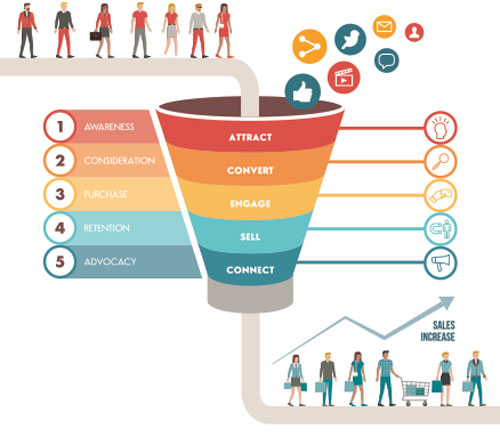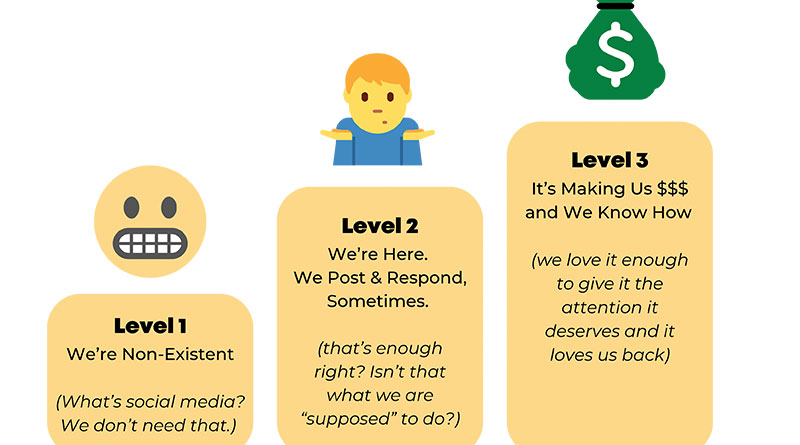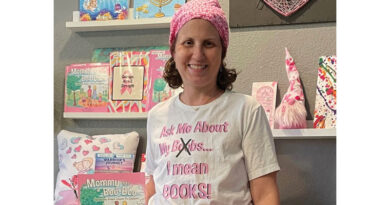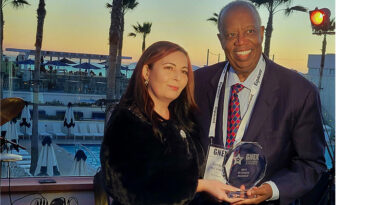Resorts Not Investing In Social Media Are Losing $$$
There’s three levels I’ve noticed resorts and companies using social media
Level One: We’re Non-Existent
(what’s social media? We don’t need that.)
Level Two: We’re Here. We Post and Respond, Sometimes.
(that’s enough right? Isn’t that what we are “supposed” to do?)
Level Three: It’s Making Us $$$ and We Know How
(we love it enough to give it the attention it deserves and it loves us back)
Social media has impactful revenue generation potential. If you are chugging along at Level Three, then congrats to you – your IT, marketing, operations, accounting and sales teams are all working together to drive some great Objectives and Key Results (OKRs) that are benefitting your bottom line. You probably don’t need to read the rest of this article.
But if you fall into level one or two, I encourage you to read on to uncover some hidden revenue opportunities you may be missing by not investing in a true social media strategy that improves the profitability of your business. Whether you are a small resort, large resort, group of resorts or B2B vendor – there’s revenue waiting for you in social media.
Sell Products Directly Through Social
Selling products to increase revenue is not a new concept to resorts, but failing to expand front-desk sales efforts online is a missed opportunity.
There’s unlimited revenue stream possibilities that easy-to-use e-commerce and social selling technology make possible for resorts and businesses of any size.
Marriott is a fantastic example of utilizing e-commerce to expand revenue channels. Their online boutique allows customers to easily order anything they’ve encountered at a Marriott property, from Ritz-Carlton toiletries to candles, lotions and diffusers in Westin’s signature scent. And if they wanted to drive even more revenue, they should consider making their posts that feature products available for purchase online into ones that are actually shoppable directly from Instagram.
With technology you don’t have to be a mega corporation, like Marriott, to add e-commerce to your website, list products, promote them on social and expand your revenue streams. There are platforms like Shopify and Woocommerce that provide all the front and back end functionality to operate an online store that can easily sync with your current accounting software.
No Product? No Problem!
If you don’t think you have a product – get creative and partner with a local designer/artist/maker/musician (especially if you find one with a massive social following) to have them collaborate on a one-of-a-kind product – from apparel/merchandise designs, signature scent, painting you can replicate prints of, photograph of the sunset from your resort printed on canvas…the possibilities are endless…just get creative and look around your community.
Work out a profit-sharing agreement, (you’re getting to use their art, their getting to use your audience of constant travelers as a sales channel) turn their artwork into merchandise, list those items on your online store/social media and capture more sales than solely selling merchandise at the front desk.
Not sure where to find someone to create something one-of-a-kind? Local boutiques may carry local artists works. Google local photographers. Get creative and you can find opportunities to develop unique products.
The best place to start though, is to ask your employees. Once while staying at a resort, I was given a beautifully hand-painted shell by one of the maintenance staff. It was his hobby and his talent was incredible. The resort could collaborate for paintings to turn into unique products. I know of another resort where the extremely talented AGM painted the stunning mural on the wall and taught weekly art classes.
From hands-off, print-on-demand options to ordering wholesale and manually listing inventory of products – there’s e-commerce sales and operations options to fit any business model.
Social media gives any company, of any size the ability to hyper-target their ideal audience on social media.
Whatever revenue goals you have – generating more bookings, finding more sales leads, identifying WARMER sales leads, selling merchandise – – there’s an advertising opportunity with a high ROI waiting for you somewhere on social media.
You just have to map out a strategy that’s aligned with your goals, identify your audience and choose the platforms that provide targeting that gets you closest to that audience. The below examples show how different the platforms and strategy can be depending on your goals:
Example Goal #1
B2B company seeking sales leads
STRATEGY: LinkedIn organic and paid campaigns targeting specific companies employees, job titles, industries.
Example Goal #2
Tour provider finding warm leads for more immediate bookings
STRATEGY: Google campaigns that target search queries that show obvious intent for upcoming travel and active in planning phase
Related: Social media and timeshare …a cautionary tale
Example Goal #3
Resort wanting to increase direct bookings
STRATEGY: Instagram campaigns (especially remarketing, more on that below) and influencer partnerships that drive awareness + action.
No matter what your business goals are, there are revenue opportunities in every social media platform to get connected with your target audience via hyper targeted ads.
Speaking of hyper targeted ads…
Don’t Fret Over 85%+ Abandon Cart Rates, Utilize Them!
The travel and tourism industry has some of the highest abandon cart rates, estimated to be as high as 87%.
A big part of this could be due to the travel shopping process. With the variable amount of taxes, cleaning fees, booking fees consumers often start the booking process during their research phase to get the full price. This leads to frequently abandoned carts since they are still researching, maybe they need to talk to their family or fellow travelers, still price shopping – whatever their process is, it’s not actually time for them to book.
Using a variety of tech and tracking solutions available, if someone is starting your booking process, there is most likely a way for you to be gathering their info as first-party data, adding them to a retargeting list and showing them ads to remain top of mind.
So while they are searching activities on Pinterest, scrolling Facebook, seeking swimsuit inspiration on Instagram or reading articles they found via their most recent Google search…you can be present during their planning phase.
Retargeting cart abandoers has been shown to increase conversion rates by 26%. That shows a profitable opportunity in turning those 80% of possible bookings that considered you but jumped ship into actual customers. Adding a special offer to remarketing efforts such as a discount or direct booking special, like late check-out, can further improve conversion rates by enticing them to book (and book directly, saving you OTA fees).
Retargeting is extra profitable because you only pay for impressions or clicks – so your audience may not be big, which means your costs will be low, but the leads will be warm so the return will be profitable.

To begin retargeting campaigns, resorts and companies simply need to work to get proper website tagging and user permissions set up on their website. That allows them to feed the customer data back to the advertising platforms of their choosing (Google, Instagram, Facebook, Pinterest, LinkedIn, direct email and so on) and showcase a variety of ads to them for a selected period of time.
You can also ensure you aren’t wasting money by sending customer data back to the same platforms as an exclusion – meaning once they become a customer and have booked, you’ll no longer be spending money showing them your ads.
If you are in B2B business development…potential clients are in research phase and end up on your site, follow them back to LinkedIn and show them content like case studies, videos, client reviews about how wonderful you are and enticing CTAs to encourage them to fully connect and open the communication that might land the sale.
Long story short, no matter what your business size, industry and goals are – there’s anyone operating in level 1-2 on social media has an opportunity for increasing revenue by investing in social.
Kelley Ellert is a marketing consultant and strategist who is on a constant search for ways to modernize resort marketing and chat strategy with other travel professionals. Look her up on LinkedIn @kelley-ellert.



